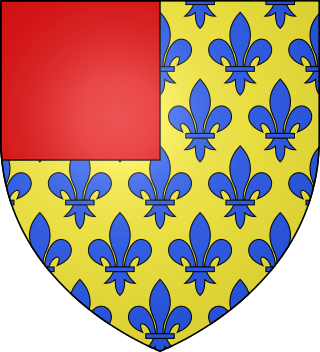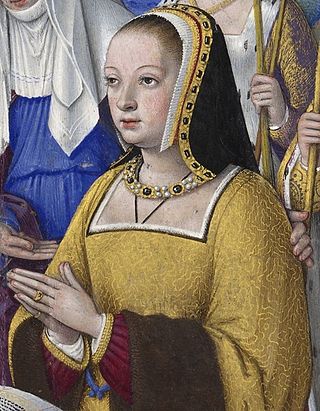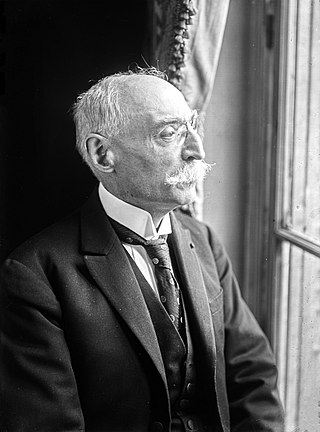Related Research Articles
A missus dominicus, Latin for "envoy[s] of the lord [ruler]" or palace inspector, also known in Dutch as Zendgraaf, meaning "sent Graf", was an official commissioned by the Frankish king or Holy Roman Emperor to supervise the administration, mainly of justice, in parts of his dominions too remote for frequent personal visits. As such, the missus performed important intermediary functions between royal and local administrations. There are superficial points of comparison with the original Roman corrector, except that the missus was sent out on a regular basis. Four points made the missi effective as instruments of the centralized monarchy: the personal character of the missus, yearly change, isolation from local interests and the free choice of the king.

Guy of Thouars was the third husband of Constance, Duchess of Brittany, whom he married in Angers, County of Anjou between August and October 1199 after her son Arthur of Brittany entered Angers to be recognized as count of the three countships of Anjou, Maine and Touraine. He was an Occitan noble, a member of the House of Thouars. He is counted as a duke of Brittany, jure uxoris, from 1199 to 1201.

Anne of Brittany was reigning Duchess of Brittany from 1488 until her death, and Queen of France from 1491 to 1498 and from 1499 to her death. She was the only woman to have been queen consort of France twice. During the Italian Wars, Anne also became Queen of Naples, from 1501 to 1504, and Duchess of Milan, in 1499–1500 and from 1500 to 1512.
Bernard Le Nail was a French writer and Breton militant. After studying commerce in Paris, he headed the promotional office of the Chamber of Commerce and Industry in Nantes. In 1979 he became Secretary General of the Comité d'Etude et de Liaison des Intérêts Bretons (CELIB) at Lanester. Between 1983 and 2000 he was director of the Cultural Institute of Brittany and had an important role in the conception and publication of the collection Les Bretons au-delà des mers : Explorateurs et grands voyageurs. He was also involved in the conception and publication of the following works: 500 Bretons à connaître, revising the Guide Bleu Bretagne, Guides Gallimard Bretagne, Les noms qui ont fait l’histoire de Bretagne, Dictionnaire des femmes en Bretagne, La Bretagne entre Armor et Argoat.

Émile Mâle was a French art historian, one of the first to study medieval, mostly sacral French art and the influence of Eastern European iconography thereon. He was a member of the Académie française, and a director of the Académie de France à Rome.

Yves Lainé is a Breton lawyer, politician and companies executive manager, now a writer, arguing for the return of Loire-Atlantique departement in the administrative région of Brittany the reunification and devolution of the historical Brittany.

The House of Baux is a French noble family from the south of France. It was one of the richest and most powerful families of Medieval Provence, known as the 'Race d’Aiglon'. They were independent Lords as castellans of Les Baux and Arles and wielded very considerable authority at local level. They held important fiefs and vast lands, including the principality of Orange.
The counts of Nantes were originally the Frankish rulers of the Nantais under the Carolingians and eventually a capital city of the Duchy of Brittany. Their county served as a march against the Bretons of the Vannetais. Carolingian rulers would sometimes attack Brittany through the region of the Vannetais, making Nantes a strategic asset. In the mid-ninth century, the county finally fell to the Bretons and the title became a subsidiary title of the Breton rulers. The control of the title by the Breton dukes figured prominently in the history of the duchy. The County of Nantes was given to Hoel, a disinherited son of a duke. He lost the countship due to a popular uprising. That uprising presented an opportunity for King Henry II of England to attack the Breton duke. In the treaty ending their conflicts, the Breton duke awarded the county to Henry II.

Jean Laroche (1921–2010) was a French poet born in Nantes. He was also a professor and had 3 children.
Renaud (795–843) was Frankish Count of Herbauges, Count of Poitiers and Count of Nantes. His name is also spelled Rainaldus or Ragenold, and he is sometimes known as Reginald in English. He is referred to as Renaud of Aquitaine, but seems to have been a member of the Rorgonid family of Maine.

Donatian and Rogatian were two brothers, martyred in Nantes during the reign of Roman Emperor Maximian, around 288–290, for refusing to deny their faith. They are also known as les enfants nantais. Their feast day is 24 May.
Gourmaëlon or Wrmaelon, was the Count of Cornouaille and de facto ruler of Brittany from 907 – c. 914. As ruler of Brittany he was considered Prince de Bretagne in some chronicles and histories. His actual history is among the least well documented of the early medieval rulers of Brittany. His reputed time of rule coincides with a dramatic increase in Viking invasions that ultimately led up to the Viking Occupation of Brittany that began after his death.
Hoël I of Brittany was an illegitimate son of Alan II and Judith. He was Count of Nantes and Duke of Brittany from 960 to 981.

The Château de Keriolet is a castle built in the 19th century in Concarneau (France).
Ricwin , was a Count of Verdun.
François-Joseph Grille was a 19th-century French man of letters, journalist and politician.
Guerech of Brittany, was Count of Nantes and Duke of Brittany from 981 to 988.

Alan was the only known son of Guerech, Duke of Brittany, and Aremberg. With his mother he founded the castle of Ancenis around 987, according to the Chronicle of Nantes. In 988, he succeeded his father as Count of Nantes and perhaps nominal Duke of Brittany, after his father was murdered by Count Conan I of Rennes. The following two years were marked by endless warfare between Rennes and Nantes. In 990, Alan died, either of an illness or else killed by Conan, who took Nantes and had himself proclaimed Duke of Brittany by the bishop of Nantes, Orscand de Vannes.

Guillaume Marie Charles Henri Mollat was a French prelate and historian.

Mathilde Alanic was a French writer of sentimental novels and short stories. Her work appeared in Les Annales politiques et littéraires, L'Eventail, Le Magasin pittoresque, Musée des familles, Le National illustré, La Petite Illustration, Le Petit Journal, Le Petit Parisien, Revue de l'Anjou, and other journals. Alanic was a recipient of the Montyon prize, Jules-Favre prize, Sobrier-Arnould prize, and was promoted Chevalier, Legion of Honour. She died in 1948.
References
- ↑ Dillange, Michel (1995). Les comtes de Poitou : ducs d'Aquitaine (778-1204). Mougon: Geste éditions. ISBN 2-910919-09-9. OCLC 35212897.
- ↑ Tonnerre, Noël-Yves (1994). Naissance de la Bretagne géographie historique et structures sociales de la Bretagne méridionale : Nantais et Vannetais de la fin du VIIIe à la fin du XIIe siècle. Impr. Jouve). Angers: Presses de l'Université d'Angers. ISBN 2-903075-58-1. OCLC 708331938.
- ↑ Kramer, Rutger (January 2015), "...Quia cor regis in manu dei est... ": The Pharaoh in Carolingian monastic narratives, Haut Moyen Âge, vol. 21, Turnhout: Brepols Publishers, pp. 139–163, doi: 10.1484/m.hama-eb.5.107349 , ISBN 978-2-503-55331-3 , retrieved 13 May 2022